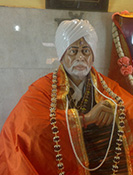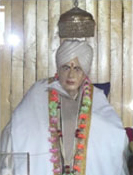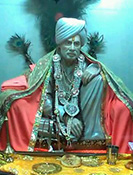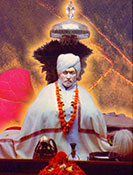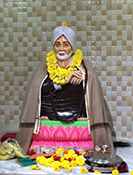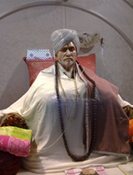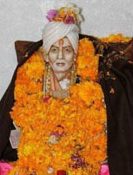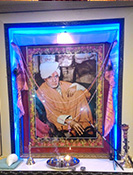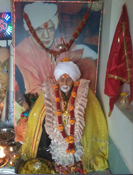Shaivism is applied in the life of Bhagavaan Ji
Dr. Radhakrishnan has very truly said that spiritual life was the true genius of India. Those who made the greatest appeal to the Indian mind were not the military conquerors, nor the rich merchants or the great diplomats but the holy sages, the Rishis who embodied spirituality at its finest and purest. The great sages and seers or the holy men had the vision to realise the truth according to the need and requirement of the time. Vedic Mantra---- Ekam Sat, Vipra Bahuda Vadanti, stands true in the highly rationalistic age. It is, therefore, no wonder why Kashmir could give its own philosophy of Shaivism. Bhagavaan Ji lived the spiritual life, according to the need of the time, place and situation. His words are Shaivistic in spirit, Shakta in practice. There seems a blending of Shiva and shakti in his Sadhana.
The mountains of the Himalayas surround the valley of Kashmir on all sides; leaving only a narrow outlet for the Vitasta at Baramulla. Kashmir valley is thus surrounded by the Himalayas and Vitasta has been the life giving energy and source for the religio-cultural ethos of Kashmir. The climate of Kashmir is fine to suit the Sadhna. People adore theNava Ratras in the spring, summer is for going to Shri Amarnath cave and other Siddha Pitas like Hareshwara, Dhyaneshwar and autumn season for Shardiya puja ,while the winter season makes the inhabitants of Kashmir to be mostly in their homes.Thus people in general would listen to the swcriptures and in Yoga and Dhyana. All this was because the sages and saints would live that life and the devotees would follow. At the fag end of winter Kashmiri Hindus observe the Maha Shivaratri with great pomp and show associated with the belief that of Shiva and Parvati getting united on that auspicious night. Many stories are connected with the celebration of the Maha Shivaratri popularly known as Herat in Kashmir
Should we believe that Harmukta, Amarnath cave or Maha Shivaratri are the source points of Shaivism for which Kashmir enjoys a special position in the globe for giving a dynamic philosophy of day to day living? Is it closely related to Vedanta System or the Sankhya System or its obligation is due to Shakti worship that we see in every corner of Kashmir or because of the impact of Tantra found prevalent in Kashmir. Kashmir is one of the Shakti pithhas on the globe. Self manifested Shila of the Chakreshwara mystic spring at Tullamula is testimony of the fact that Siddha Purushas devoted much of their time in meditation and Sadhana at Hari Parbat and Tullamulla. Bab Bhagavaan Ji devoted much of his time in and around the Hari Parbat. The Mahakali shrine at Srinagar,Pokhribal spring at the feet of the Hari Parbat,. Mystic spring at Raithan is related to Bhawani Raginya Devi and Papharan Nag near Mattan is a Shiva spring. Mattan Nag stands itself the base camp for the devotees proceeding to the Amarnath cave via Pahalgam for the Amarnath pilgrimage.
Philosophy in its widest etymological sense means “love of knowledge.” It tries to know things that immediately and remotely concern man. What is the real nature of man? What is the end of this life? What is the nature of this world in which he lives? Is there any creator of this world? How should man live in the light of his knowledge of himself, the world and God? These are some of many problems that have been discussed threadbare in the Shaiva philosophy. It is easily intelligible because it does believe in the existence of matter and spirit. Life is worth knowing and hence worth enjoying, but in the Dharmik way--as described in the Dharma Shastras. There seems to be vision of truth (darshana), in the life of Bab Ji, which is hidden in the sence that he would remain in silence. Silence speaks more that words and does miracles than Pravachans /discourses.
ln the " The Spirit of India ",Rabindranath Tagore " Brahman is Truth, Wisdom and Infinite, which is Satyam, Jnanam Anantam Brahma. Peace is in Brahma, goodness is in Brahma and the unity of all things is in Brahma. He who is one, who is above all colour distinctions, who dispenses the inherent needs of men of all colours, who comprehends all things from their beginning to the end. Let Him unite us to one another with wisdom which is the wisdom of goodness. This way of life is said to be the saintly or spiritual life. Bab Ji lived within the frame work of integrity and unity - this has been told to me by Pt. P N Koul Ji. He would always be with a smile on his face. but in the meditative thought.
Further, in Shaiva system, there are seven mixed principles where Mula Prakriti is termed as “Prakriti-Maya ". It is the product of “Ashudda Maya and it evolves primarily into three principles- Kala (Time), Niyati (Destiny) and Kala. Time is an independent Principle. In experience, we observe that even when all necessary causes are present, the effect is not produced except with the passage of time.
Bab Bhagavaan Ji would say "Ahankaras Chhuyi Namaskar', Tami Seit Bani Sakhyatkaar". Literally, it means bow down before ego--the Ahankara is the strength of the psyche, but it should not govern us, rather we must draw a thin line between the Ahankara and thereal Self, which is Jivatma, as we have to recognize the Self, which is Shiva consciousness.
The Rudra Mantras which were very dear to Bhagavaan Ji are translated as under;
" Prostrations to the Lord, the Master of the Universe, the great God, the three eyed one, the destroyer of Tripura, the extinguisher of the Trika fire and the fire of death, the blue-necked one, the Victor over Death, the Lord of all, the ever peaceful one, the glorious God of gods. He is attained by Tapas or austerity and comes to our refuge and frees us from all bondage.
Paartheshvara or Lingam has been the emblem of Siva. Lingam happens to be a pillar of cosmic fire, whose top and bottom could not be seen by Brahma and Vishnu.
Siva is known as Pashupati (the lord of creatures). Kaivalya Upanishad describes Sivayoga as a means of release. Shaivism closely agrees with the Sankhya in its dogmatics and with the Yoga school in its practical discipline.
Role of Shakti in Shaivism is clear from, Bhawani and Rajina Sahasranam, Sharika Sahsranaama. Sri Chakra worship stands a witness to the unification of Shakti and Siva. Sri Chakra is the symbol of the infinite.
The unseen bindu grew visible to the devotees. For a spiritual aspirant Audacious lines were traced upon the Void; which is Shunya. The infinite was reduced to Trikona Vasukona and Dasharyugma, rainging symbol and significance in the realm of the Shakti Devi's Bijaksharas
They framed the Anushthans of the Cosmic Law, which is Satyam and Ritam, according to Bab Ji.
Sri Chakra is verily the macrocosm as well as the microcosm, is the body of the two in one, Siva Shakti. Sri Aurobindo emphasised it as under:
- "This is the knot that ties together the stars;
- The two who are one and the Secret of all power,
- The two who are one are the might and right in things "
- Savitri ( 1.4 )
If we observe the Yantras of Sharada AUM and see the symmetry of lines, as drawn by Bab Ji, it appears to be very artistic and cabbalic in nature. Sharada Mata abides in that Yantra,as the source of all the Vedas is AUM. AUM is the Pranava-meaning there by as being soothing, refreshing with "Satyam and Ritam”.
According to the Trika, the Shastras have eternal existence. It means wisdom, self-existent and impersonal. It is also known as ' Shabda ' and ' Vak. ‘Shastra is authority according to Tantrasara, told or revealed by the Supreme Lord. Therefore, Shabda creates or manifests every thing. Reality is ineffable and beyond any descriptions. Trika tries to formulate a philosophy about its nature. Shiva and Shakti are not two separate realities.
Kalidasa in Raghu Vamsa refers to Shiva and Shakti as:
"Vagarthau samprikhtau Vagarthau Pratpadye, Jagtah Pitarau Vande Parvati Parameshwarau ".Ot is word with its meaninglikeShiva and Shakti blended together. Like fire and its burning power, Shiva and Shakti are the same identical facts though they are spoken of as distinet ( Siv Drishti III. 7 ). Shakti is known as Swantriya and the principles of universal manifestation of five fold aspects as Chit Shakti- the power of self consciousness entails Ananda enjoyment and wonderment on the part of Shiva, bliss gives rise to Ichha, desire to create, then Jnana or knowledge leading to Kriya Shakti --a will to act.
Siva as Shakti manifests Himself as a correlated order of knowers, knowables and means of knowledge. The limited individual is subject to ignorance, which according to Trika is two fold viz. paurasha and bandha. The descent of the force of grace achieves two purposes: first Paasha-kshya, the destruction of fetters and secondly Shivatva yoga - the restoration of Shiva-hood. The most important of this is Diksha or initiation. The Trika says that is a result of Shaktipat, One is brought to a real Guru, or drawn towards a guru,is the matter of Purva Sanskaras.. It awakens the " kriya-shakti " in the limited soul. There are four " upayas " or means of attaining the supreme goal. They are "anupaya; Shambhava, Shakta and Anav upaya ". Due to Shaktipat or descent of grace in a very intense degree, everything is needed for the realisation, beginning from the liquidation of the atomic impurity down to the recognition of the state of Paramashiva may be achieved by the aspirant immediately and without going through any Sadhna or discipline. Samvid is the only reality, knowledge of duality is nothing in itself and can be removed through the rise of Shuddha Vikapa of Nirvikalpa. "
Dhyana means meditation in the hear space or " Hriday-Akash " on the Supreme Reality. By the process of meditation the whole field of knowables is swallowed up and absorbed into the knower. Ucchara means the directing the Pranas or vital force upwards in the process of meditation. Through these already experienced means, the limited individual attains the rich treasures of his own true Self.
Chamanlal Raina






